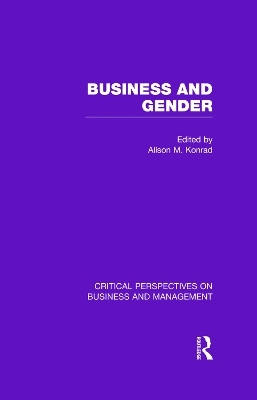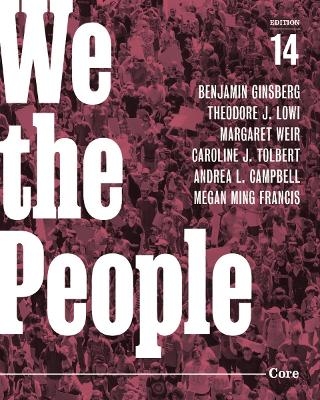
Business and Gender
Routledge
978-0-415-66656-5 (ISBN)
With a new introduction by the editor to place the collected material in its historical and intellectual context and including a comprehensive index, this collection is a convenient and authoritative reference resource on business and gender for both student and scholar.
cONTENTS
Volume I: DOCUMENTING AND ANALYsING THE STATUS OF WOMEN
Part 1: Documenting the Status of Women in Business
1. R. L. Oaxaca, `Estimation of Union-Nonunion Wage Differentials Within Occupational Regional Subgroups’, Journal of Human Resources, 1975, 10, 4, 529–37.
2. F. D. Blau and L. M. Kahn, `The U.S. Gender Pay Gap in the 1990s: Slowing Convergence’, Industrial & Labor Relations Review, 2006, 60, 1, 45–66.
3. H. Antecol, A. Jong, and M. Steinberger, `The Sexual Orientation Wage Gap: The Role of Occupational Sorting and Human Capital’, Industrial & Labor Relations Review, 2008, 61, 4, 518–43.
4. D. J. Maume, Jr., `Glass Ceilings and Glass Escalators: Occupational Segregation and Race and Sex Differences in Managerial Promotions’, Work & Occupations, 1999, 26, 483–509.
5. P. Tharenou, S. Latimer, and D. Conroy, `How Do You Make it to the Top? An Examination of Influences on Women’s and Men’s Managerial Advancement’, Academy of Management Journal, 1994, 37, 4, 899–931.
6. E. L. J. E. Bell and S. M. Nkomo, `Barriers to Advancement’ and `Climbing Over the Barriers’, Our Separate Ways: Black and White Women and the Struggle for Professional Identity (Harvard Business School Press, 2001), pp. 137–58.
Part 2: Testing and Questioning Economic Theories Explaining Women’s Lower Status in Business
7. D. D. Bielby and W. T. Bielby, `She Works Hard for the Money: Household Responsibilities and the Allocation of Work Effort’, American Journal of Sociology, 1988, 93, 5, 1031–59.
8. J. A. Jacobs and R. J. Steinberg, `Compensating Differentials and the Male–Female Wage Gap: Evidence from the New York State Comparable Worth Study’, Social Forces, 1990, 69, 2, 439–68.
9. J. N. Baron, A. Davis-Blake, and W. T. Bielby, `The Structure of Opportunity: How Promotion Ladders Vary Within and Among Organizations’, Administrative Science Quarterly, 1986, 31, 2, 248–73.
10. D. Tomaskovic-Devey and S. Skaggs, `An Establishment-Level Test of the Statistical Discrimination Hypothesis’, Work & Occupations, 1999, 26, 4, 422–45.
11. B. F. Reskin and P. A. Roos, `Queuing and Changing Occupational Composition Job Queues’, Gender Queues: Explaining Women’s Inroads Into Male Occupations (Temple University Press, 1990), pp. 29–68.
12. A. Levanon, P. England, and P. Allison, `Occupational Feminization and Pay: Assessing Causal Dynamics Using 1950–2000 U.S. Census Data’, Social Forces, 2009, 88, 2, 865–92.
Part 3: Theorizing Women’s Relatively Low Status in Business
13. R. M. Kanter, `Numbers: Minorities and Majorities’, Men and Women of the Corporation (Basic Books, 1977), pp. 206–42.
14. J. Acker, `Inequality Regimes: Gender, Class, and Race in Organizations’, Gender & Society, 2006, 20, 4, 441–64.
15. M. B. Calás and L. Smircich, `From the "Woman’s Point of View" Ten Years Later: Towards a Feminist Organization Studies’, in S. R. Clegg, C. Hardy, and W. R. Nord (eds.), Handbook of Organization Studies (Sage, 2006), pp. 284–346.
16. E. Holvino, `Intersections: The Simultaneity of Race, Gender and Class in Organization Studies’, Gender, Work & Organization, 2010, 17, 3, 248–77.
Part 4: Revealing the Gendered Nature of Workplace Structures and Processes
17. J. Martin, `Hidden Gendered Assumptions in Mainstream Organization Theory and Research’, Journal of Management Inquiry, 2000, 9, 2, 207–16.
18. J. K. Fletcher, `Relational Practice: A Feminist Reconstruction of Work’, Journal of Management Inquiry, 1998, 7, 2, 163–86.
19. Y. Benschop and H. Doorewaard, `Six of One and Half a Dozen of the Other: The Gender Subtext of Taylorism and Team-Based Work’, Gender, Work & Organization, 1998, 5, 1, 5–18.
20. R. Kark and R. Waismel-Manor, `Organizational Citizenship Behaviour: What’s Gender Got to Do With it?’, Organization, 2005, 12, 6, 889–917.
21. A. J. Mills, `Studying the Gendering of Organizational Culture Over Time: Concerns, Issues and Strategies’, Gender, Work & Organization, 2002, 9, 3, 286–307.
Volume II: ATTITUDES AND SOCIAL INTERACTION
Part 5: Women in Leadership
22. V. E. Schein, R. Mueller, T. Lituchy, and J. Liu, `Think Manager—Think Male: A Global Phenomenon?’, Journal of Organizational Behavior, 1996, 17, 1, 33–41.
23. D. Collinson and J. Hearn, `Naming Men as Men: Implications for Work, Organization and Management’. Gender, Work & Organization, 1994, 1, 1, 2–22.
24. A. H. Eagly, M. G. Makhijani, and B. G. Klonsky, `Gender and the Evaluation of Leaders: A Meta-Analysis’, Psychological Bulletin, 1992, 111, 1, 3–22.
25. A. H. Eagly, M. C. Johannesen-Schmidt, and M. L. van Engen, `Transformational, Transactional, and Laissez-Faire Leadership Styles: A Meta-Analysis Comparing Women and Men’, Psychological Bulletin, 2003, 129, 4, 569–91.
26. M. Maier, `Gender Equity, Organizational Transformation, and Challenger’, Journal of Business Ethics, 1997, 16, 9, 943–62.
27. A. Panayiotou, `"Macho" Managers and Organizational Heroes: Competing Masculinities in Popular Films’, Organization, 2010, 17, 6, 659–83.
28. Y. Due Billing and M. Alvesson, `Questioning the Notion of Feminine Leadership: A Critical Perspective on the Gender Labelling of Leadership’, Gender, Work & Organization, 2000, 7, 3, 144–57.
Part 6: Gender and Interpersonal Interaction in Organizations
29. S. Gherardi, `The Gender We Think, the Gender We Do in Our Everyday Organizational Lives’, Human Relations, 1994, 47, 6, 591–610.
30. D. Kipnis and S. M. Schmidt, `Upward-Influence Styles: Relationship with Performance Evaluations, Salary, and Stress’, Administrative Science Quarterly, 1988, 33, 4, 528–42.
31. A. S. Tsui and C. A. I. O’Reilly, `Beyond Simple Demographic Effects: The Importance of Relational Demography in Superior-Subordinate Dyads’, Academy of Management Journal, 1989, 32, 2, 402–23.
32. H. Ibarra, `Homophily and Differential Returns: Sex Differences in Networks Structure and Access in an Advertising Firm’, Administrative Science Quarterly, 1992, 37, 3, 422–47.
33. B. R. Ragins and J. L. Cotton, `Mentor Functions and Outcomes: A Comparison of Men and Women in Formal and Informal Mentoring Relationships’, Journal of Applied Psychology, 1999, 84, 4, 529–50.
34. L. M. Cortina, `Unseen Injustice: Incivility as Modern Discrimination in Organizations’, Academy of Management Review, 2008, 33, 1, 55–75.
Part 7: Sex, Gender, and Sexual Orientation in the Workplace
35. G. Burrell, `Sex and Organizational Analysis’, Organization Studies, 1984, 5, 2, 97–118.
36. B. A. Gutek, `Sexual Harassment: Nature and Frequency’, Sex and the Workplace (Jossey-Bass, 1985), pp. 42–60.
37. C. R. Willness, P. Steel, and K. Lee, `A Meta-Analysis of the Antecedents and Consequences of Workplace Sexual Harassment’, Personnel Psychology, 2007, 60, 1, 127–62.
38. M. Dietert and D. Dentice, `Gender Identity Issues and Workplace Discrimination: The Transgender Experience’, Journal of Workplace Rights, 2009, 14, 1, 121–40.
39. B. R. Ragins and J. M. Cornwell, `Pink Triangles: Antecedents and Consequences of Perceived Workplace Discrimination Against Gay and Lesbian Employees’, Journal of Applied Psychology, 2001, 86, 6, 1244–61.
40. S. L. Singletary and M. R. Hebl, `Compensatory Strategies for Reducing Interpersonal Discrimination: The Effectiveness of Acknowledgements, Increased Positivity, and Individuating Information’, Journal of Applied Psychology, 2009, 94, 3, 797–805.
Volume III: WORK–FAMILY INTERFACE
Part 8: The Clash Between Production and Reproduction
41. J. Acker, `Hierarchies, Jobs, and Bodies: A Theory of Gendered Organizations’, Gender & Society, 1990, 4, 2, 139–58.
42. C. Cockburn, `Defined in Domesticity’, In the Way of Women: Men’s Resistance to Sex Equality in Organizations (ILR Press, 1991), pp. 76–104.
43. J. A. Schneer and F. Reitman, `Managerial Life Without a Wife: Family Structure and Managerial Career Success’, Journal of Business Ethics, 2002, 37, 1, 25–38.
44. C. Gatrell, `Policy and the Pregnant Body at Work: Strategies of Secrecy, Science and Supra-Performance’, Gender, Work & Organization, 2011, 18, 2, 158–81.
Part 10: The Impact of the Gender Division of Labour in the Household
45. S. M. Bianchi and M. A. Milkie, `Work and Family Research in the First Decade of the 21st Century’, Journal of Marriage & Family, 2010, 72, 3, 705–25.
46. A. M. Konrad, J. E. Ritchie, Jr., P. Lieb, and E. A. Corrigall, `Sex Differences and Similarities in Job Attribute Preferences: A Meta-Analysis’, Psychological Bulletin, 2000, 126, 4, 593–641.
47. R. J. Ely and I. Padavic, `A Feminist Analysis of Organizational Research on Sex Differences’, Academy of Management Review, 2007, 32, 4, 1121–43.
48. P. E. Becker and P. Moen, `Scaling Back: Dual-Earning Couples’ Work–Family Strategies’, Journal of Marriage & Family, 1999, 61, 4, 995–1007.
49. C. Guillaume and S. Pochic, `What Would You Sacrifice? Access to Top Management and the Work–Life Balance’, Gender, Work & Organization, 2009, 16, 1, 14–36.
Part 11: Managing the Work–Life Interface
50. M. R. Frone, M. Russell, and M. L. Cooper, `Antecedents and Outcomes of Work–Family Conflict: Testing a Model of the Work–Family Interface’, Journal of Applied Psychology, 1992, 77, 1, 65–78.
51. E. E. Kossek, J. A. Colquitt, and R. A. Noe, `Caregiving Decisions, Well-Being, and Performance: The Effects of Place and Provider as a Function of Dependent Type and Work–Family Climate’, Academy of Management Journal, 2001, 44, 1, 29–44.
52. K. Byron, `A Meta-Analytic Review of Work–Family Conflict and its Antecedents’, Journal of Vocational Behavior, 2005, 67, 2, 169–98.
53. M. N. Ruderman, P. J. Ohlott, K. Panzer, and S. N. King, `Benefits of Multiple Roles for Managerial Women’, Academy of Management Journal, 2002, 45, 2, 369–86.
54. J. H. Greenhaus and G. N. Powell, `When Work and Family are Allies: A Theory of Work–Family Enrichment’, Academy of Management Review, 2006, 31, 1, 72–92.
Volume IV: STRATEGIES FOR CHANGE
Part 12: Governmental Employment Equity and Affirmative Action Programmes
55. D. A. Kravitz and J. Platania, `Attitudes and Beliefs About Affirmative Action: Effects of Target and Respondent Sex and Ethnicity’, Journal of Applied Psychology, 1993, 78, 6, 928–38.
56. M. E. Heilman, C. J. Block, and P. Stathatos, `The Affirmative Action Stigma of Incompetence: Effects of Performance Information Ambiguity’, Academy of Management Journal, 1997, 40, 3, 603–25.
57. A. M. Konrad and F. Linnehan, `Formalized HRM Structures: Coordinating Equal Employment Opportunity or Concealing Organizational Practices?’, Academy of Management Journal, 1995, 38, 3, 787–820.
58. A. Kalev, F. Dobbin, and E. L. Kelly, `Best Practices or Best Guesses? Assessing the Efficacy of Corporate Affirmative Action and Diversity Policies’, American Sociological Review, 2006, 71, 4, 589–617.
59. J. Rubery, `Reflections on Gender Mainstreaming: An Example of Feminist Economics in Action?’, Feminist Economics, 2005, 11, 3, 1–26.
Part 13: Theorizing Resistance to the Achievement of Gender Equality in the Workplace
60. C. Agócs, `Institutionalized Resistance to Organizational Change: Denial, Inaction and Repression’, Journal of Business Ethics, 1997, 16, 9, 917–31.
61. D. Jones and R. Torrie, `Entering the Twilight Zone: The Local Complexities of Pay and Employment Equity in New Zealand’, Gender, Work & Organization, 2009, 16, 5, 559–78.
62. A. Sinclair, `Critical Diversity Management Practice in Australia: Romanced or Co-Opted?’, in A. M. Konrad, P. Prasad, and J. K. Pringle (eds.), Handbook of Workplace Diversity (Sage, 2006), pp. 511–30.
Part 14: Organizational Strategies to Achieve Gender Equality
63. D. E. Meyerson and M. A. Scully, `Tempered Radicalism and the Politics of Ambivalence and Change’, Organization Science, 1995, 6, 5, 585–600.
64. J. E. Dutton, S. J. Ashford, K. A. Lawrence, and K. Miner-Rubino, `Red Light, Green Light: Making Sense of the Organizational Context for Issue Selling’, Organization Science, 2002, 13, 4, 355–69.
65. P. Moen, E. L. Kelly, and R. Hill, `Does Enhancing Work–Time Control and Flexibility Reduce Turnover? A Naturally Occurring Experiment’, Social Problems, 2011, 58, 1, 69–98.
66. R. J. Ely and D. E. Meyerson, `An Organizational Approach to Undoing Gender: The Unlikely Case of Offshore Oil Platforms’, in A. P. Brief and B. M. Staw (eds.), Research in Organizational Behavior: An Annual Series of Analytical Essays and Critical Reviews (Elsevier, 2010), pp. 3–34.
67. A.-M. Greene and G. Kirton, `Trade Unions and Equality and Diversity’, in A. M. Konrad, P. Prasad, and J. K. Pringle (eds.), Handbook of Workplace Diversity (Sage, 2006), pp. 489–510.
68. A. Bruni, S. Gherardi, and B. Poggio, `Entrepreneur-Mentality, Gender and the Study of Women Entrepreneurs’, Journal of Organizational Change Management, 2004, 17, 3, 256–68.
| Erscheint lt. Verlag | 20.4.2012 |
|---|---|
| Reihe/Serie | Critical Perspectives on Business and Management |
| Verlagsort | London |
| Sprache | englisch |
| Maße | 156 x 234 mm |
| Gewicht | 3946 g |
| Themenwelt | Schulbuch / Wörterbuch ► Lexikon / Chroniken |
| Sozialwissenschaften ► Politik / Verwaltung ► Staat / Verwaltung | |
| Sozialwissenschaften ► Soziologie ► Gender Studies | |
| Wirtschaft ► Betriebswirtschaft / Management | |
| Wirtschaft ► Volkswirtschaftslehre | |
| ISBN-10 | 0-415-66656-2 / 0415666562 |
| ISBN-13 | 978-0-415-66656-5 / 9780415666565 |
| Zustand | Neuware |
| Haben Sie eine Frage zum Produkt? |
aus dem Bereich


